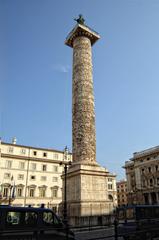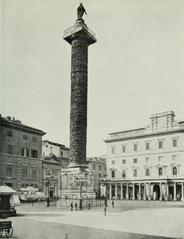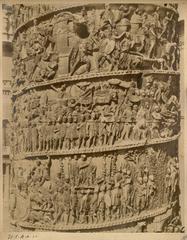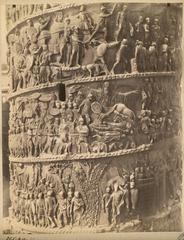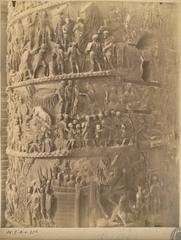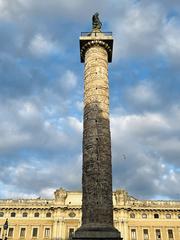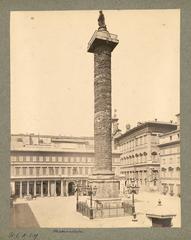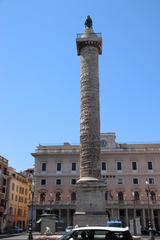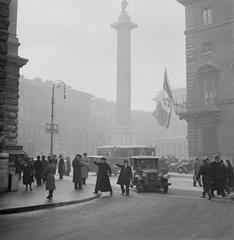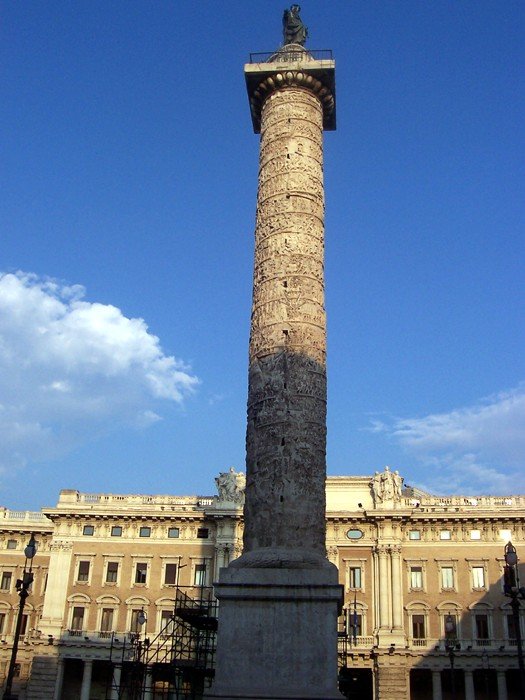
Visiting the Column of Marcus Aurelius, Rome: Tickets, Hours, and Essential Tips
Date: 14/06/2025
Introduction: History and Significance
The Column of Marcus Aurelius, rising majestically in Rome’s Piazza Colonna, is not only a striking monument to imperial power but also a vivid narrative carved in stone. Erected between 176 and 193 CE, this ancient column commemorates Emperor Marcus Aurelius’s victories in the Marcomannic Wars. Its 2,000-plus figures, spiraling around the shaft in dynamic scenes of battle and diplomacy, make it a masterpiece of Roman art and a powerful tool of imperial propaganda.
Easily accessible in the heart of Rome’s historic center, the column is surrounded by landmarks like the Pantheon and Trevi Fountain. While the interior spiral staircase is closed for preservation, the exterior’s intricate reliefs can be admired at any time, free of charge. This guide details everything you need to know for a rewarding visit: hours, tickets, accessibility, historical context, and nearby attractions. To deepen your experience, resources such as Turismo Roma, World History Edu, and Musei Capitolini provide authoritative information.
Table of Contents
- Why Visit the Column of Marcus Aurelius?
- History and Symbolism
- Architectural and Artistic Features
- Visiting Information: Location, Hours, and Tickets
- Tips for Seeing the Column
- Accessibility and Safety
- Nearby Attractions and Suggested Itineraries
- Guided Tours and Audio Guides
- Frequently Asked Questions
- Conclusion and Practical Summary
- References
Why Visit the Column of Marcus Aurelius?
The Column of Marcus Aurelius is a highlight for anyone interested in ancient history, art, or architecture. Standing nearly 40 meters high (with an additional 7 meters below ground), it is a testament to Roman engineering and artistry. Its continuous spiral reliefs narrate the emperor’s military campaigns, creating a visual chronicle of the Marcomannic Wars and underscoring the emperor’s virtues, such as courage, piety, and clemency (Ancient Rome Live; World History Edu).
The column’s central location and free accessibility make it an essential stop on any tour of Rome’s historic core.
History and Symbolism
Commissioned after Marcus Aurelius’s death by his son Commodus, the column not only memorializes military success but also reinforces the legitimacy of the Antonine dynasty. The reliefs, carved in Carrara marble, depict more than 2,000 figures illustrating scenes of battle, diplomacy, and religious ritual. These stories emphasize both the emperor’s prowess and his philosophical ideals, immortalizing him as both a warrior and a Stoic philosopher-king (Turismo Roma).
The column’s iconography includes scenes of Roman soldiers, enemy tribes, and divine intervention—such as the celebrated “Miracle of the Rain,” where a storm saves the Roman army. It also features personifications of Victory and episodes highlighting imperial clemency.
Architectural and Artistic Features
- Dimensions and Structure: The column stands about 39 meters above ground and is constructed from 28 massive blocks of Carrara marble. An internal spiral staircase (now closed) once allowed access to a viewing platform atop the monument (Roman Empire History; Summer in Italy).
- Spiral Reliefs: The reliefs spiral around the shaft for 100+ meters, densely populated with expressive figures. The deep carving and dramatic style reflect the turbulence of the emperor’s campaigns and a shift in Roman art during the late 2nd century CE.
- Summit Statue: Originally crowned with a bronze statue of Marcus Aurelius, the summit now displays a statue of St. Paul, added in 1589 by Pope Sixtus V to mark Rome’s Christian transformation.
- Base and Inscriptions: The base, partly buried due to rising street levels, features dedicatory inscriptions and once displayed scenes honoring Marcus Aurelius and Faustina.
Visiting Information: Location, Hours, and Tickets
Location
The column is centrally located in Piazza Colonna, along Via del Corso in Rome’s historic center. It’s a short walk from major attractions like the Pantheon and Trevi Fountain (colosseumrometickets.com; mapcarta.com).
Hours
Accessible 24/7, the column can be viewed anytime. There are no gates or restrictions around Piazza Colonna (trip.com).
Tickets and Admission
No ticket is required to view the column’s exterior; access is free at all times. While the interior is closed for safety and preservation, nearby museums and guided tours may require tickets (Turismo Roma).
Getting There
- Metro: Barberini (Line A) is a 10-minute walk away.
- Bus: Numerous lines serve Via del Corso and Piazza Venezia.
- Taxi and Ride-Sharing: Easily available in the area.
Tips for Seeing the Column
- Best Times: Early morning or late afternoon offer the best lighting and fewer crowds for both viewing and photography. The column is also beautifully illuminated at night.
- Viewing Details: The reliefs are high up—bring binoculars or a zoom lens for close-ups.
- Accessibility: The square is flat and paved, making it accessible for visitors with mobility challenges.
- Amenities: Surrounding the piazza are cafes, shops, and restaurants. Public restrooms are available nearby, such as in the Pantheon or Galleria Alberto Sordi.
Accessibility and Safety
Piazza Colonna is pedestrian-friendly and generally safe, with a visible police presence due to nearby government buildings. As in all major tourist destinations, be mindful of pickpockets. Respect the column by not climbing or touching the base, as it is a protected monument.
Nearby Attractions and Suggested Itineraries
- Pantheon: Five-minute walk; one of the best-preserved ancient Roman temples.
- Trevi Fountain: Ten minutes on foot; a Baroque masterpiece.
- Piazza Venezia: Fifteen-minute walk; home to the monumental Vittoriano.
- Palazzo Colonna: Opulent palace open for guided tours on select days.
Plan a self-guided walking tour using resources like GPSmyCity.
Guided Tours and Audio Guides
Many Rome walking tours include the Column of Marcus Aurelius, offering historical and artistic context. Tour prices vary depending on the length and inclusions. Audio guides and mobile apps like Audiala or GPSmyCity can turn your smartphone into a personal guide.
Frequently Asked Questions
Q: What are the visiting hours?
A: The column is outdoors and accessible 24/7.
Q: Is there an entrance fee?
A: No, viewing the column’s exterior is free.
Q: Can I climb the column?
A: No, the interior staircase is closed to the public.
Q: Are guided tours available?
A: Yes, many city tours include the column, and audio guides are widely available.
Q: Is it accessible for visitors with disabilities?
A: The piazza is level and paved, suitable for visitors with mobility challenges.
Conclusion and Practical Summary
The Column of Marcus Aurelius remains a profound symbol of Rome’s imperial history and artistic achievement. Its central location, free access, and proximity to major sites make it an essential stop for every visitor. For the best experience, visit during quieter hours, bring binoculars for detail, and consider a guided tour or audio guide for deeper insight. Explore nearby landmarks to enrich your journey through Rome’s historic center.
Stay updated by consulting official resources like Turismo Roma and following social media for the latest tips. Download the Audiala app for interactive audio guides and exclusive content.

